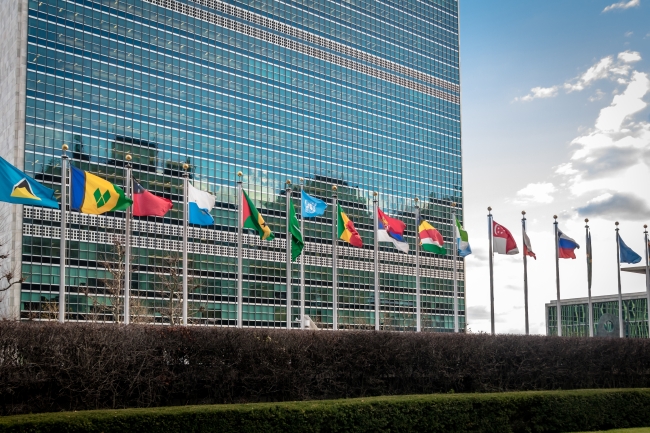Sustainable finance: A transition framework to reach the SDGs
15 NOVEMBER, 2022

The green and sustainable finance sectors have grown quickly in recent years. Still, efforts to support climate-aligned financing have primarily concentrated on "pure green" activities -i.e., limited activities associated with a near-zero or zero-carbon economy. Such pure green activities are estimated to make up less than 8% of the global economy.
The support for the broader range of investments required for the whole-of-economy climate transition, including transition activities and investments made by greenhouse gas-intensive sectors and firms, has been limited, with some industries finding it increasingly difficult to comply.
However, the ability of sectors or businesses to access financing to enable their transition to net-zero emissions can be improved with the support of an efficient framework for transition finance. This could assist them in reducing the potential negative consequences of a disorderly shift, such as transition risks related to the environment, limited access to inexpensive and dependable energy, unemployment, and perhaps broader social implications.
In 2022, the work of the Sustainable Finance Working Group (SFWG) was rooted in the G20 Sustainable Finance Roadmap (the "Roadmap") actions, which were endorsed by the G20 Leaders at the 2021 Rome Summit. These actions were also acknowledged earlier this year at the G20 Finance Ministers and Central Bank Governor (FMCBG) Meetings as essential to the accomplishment of the 2030 Agenda for Sustainable Development in accordance with the UN Framework Convention on Climate Change (UNFCCC) and the Paris Agreement.
The G20 Sustainable Finance Roadmap calls for several actions to better incorporate transitional issues into sustainable finance methodologies. The Roadmap requests that the G20 SFWG works with relevant International Organizations to develop high-level principles for a credible and consistent framework for financing a just climate transition.
An effective framework can also reduce the risks of “green and SDG washing”.
Against this background and after drawing inputs from various international organizations and analysing market practices in 2021 and 2022, the SFWG has developed a set of high-level principles on transition finance. Transition finance, as discussed in the report, refers to financial services supporting the whole-of-economy transition, in the context of the Sustainable Development Goals (SDGs), towards lower and net-zero emissions and climate resilience, in a way aligned with the goals of the Paris Agreement.
This includes specific principles around the interconnected five pillars of the transition finance framework listed below. The initial focus of the SFWG recommended principles for the transition finance framework is to guide the development of policies and financial services to support the climate-related transition.
The five pillars:
- Identification of transitional activities and investments,
- Reporting of information on transition activities and investments,
- Developing transition-related finance instruments,
- Designing policy measures, and
- Assessing and mitigating negative social and economic impact of transition activities and investments.
Pillar 1. Identification of transitional activities and investments
An important foundation for scaling up transition finance is to coordinate internationally on how the financial sector should identify transitional activities and investments, engage with relevant firms to provide the appropriate financing needed and help promote the credibility of these activities and investments in contributing to climate goals.
Drawing on inputs from members and knowledge partners, country case experiences, Financial Institutions (FIs) and sector specialists, the SFWG reviewed a range of approaches, including:
- Principle-based approaches to identify tools that can help support climate transitional activities and relevant investments. They can provide guidance on transition plans, strategies, emission reduction targets, timeframes, transparency and verifiability.
- Taxonomy-based approaches can be used by investors and companies to identify, label, and report on transition activities as well as enable the measurement/monitoring of transition performance.
- Combination of approaches, where some sectors/activities areas are defined using a taxonomy-based approach, and other sectors/activities are identified by a principles-based approach.
Regardless of the specific approach used, they should all work toward the same goals: assisting Financial Institutions and project owners in identifying transition activities or pertinent opportunities for transitional investment, understanding their roles in the climate transition, lowering market frictions and costs, and improving transparency and credibility.
This year, the SFWG has developed a set of high-level principles for jurisdictions that intend to develop or adopt different approaches to identify transition activities or investment opportunities. Among other principles, approaches should:
- Include clear recommendations around verifiability of transition activities or investments (e.g., by providing guidance for transparency, benchmarking, or independent verification), including their alignment with GHG (Greenhouse Gas) pathways consistent with the goals of the Paris Agreement;
- Consider and include measures to facilitate an orderly, just and affordable transition, while avoiding or mitigating possible negative impacts on employment and affected households, communities, and other SDGs (including environment protection and biodiversity), or risks to energy security and price stability;
To read the first 7 principles, please check the G20 2022 Sustainable Finance Report.
Pillar 2. Reporting of information on transition activities and investments
At the corporate, portfolio, and project levels, transition-aligned reporting procedures may already be in use in the public or private sector. The Climate Transition Finance Handbook or the well-known Green Bond Principles, the Guidance on Metrics, Targets, and Transition Plans of Financial Stability Board (FSB)'s Task Force on Climate-Related Financial Disclosures (TCFD), and some jurisdictions, countries, stock exchanges, and FIs have issued mandatory requirements for reporting on transition activities or relevant investments.
Reliable, consistent, verifiable, and comparable information on transition financing, as well as cooperation and interoperability between the global baseline and domestic legal frameworks are all crucial factors to transitional activities.
Based on a review of current market practices, the SFWG recommends that the reporting framework for transition activities and investment opportunities, include at least the following elements:
- Disclose up-to-date transition plans, with credible and ideally verifiable, comparable, science-based interim and long-term goals, and timelines for achievement (for example, technical pathways, fundraising and investment plans etc.);
- Disclose climate data including Scope 1 and Scope 2 GHG emissions data, and material Scope 3 data as it becomes possible. The disclosure of Scope 3 emissions data can progress using a phased approach, as it becomes possible, reflecting progress on data availability and capacity. Firms should report on relevant approaches and policies for disclosure, such as the internal carbon price used, and the characteristics of carbon credits or carbon offsets used to meet the transition targets;
- Disclose corporate governance arrangements that ensure such transition activities or plans will be implemented properly, including with respect to risk management systems and due diligence processes;
To read the principles 8 to 13, please check the G20 2022 Sustainable Finance Report.
Pillar 3. Transition-related financial instruments
A wide range of relevant financial instruments will be critical to the transition.
Based on current market practices, input from knowledge partners, and engagement with the private sector and other stakeholders, the SFWG identified a suite of financial products and toolboxes that can be included as transition finance instruments.
Debt instruments can include use-of-proceeds green/transition bonds/loans, sustainability-linked loans or bonds, or fixed/term deposits, reimbursable loans and other debt
finance instruments. Equity-related instruments can include transition-focused buyout funds, venture capital funds, and mezzanine financing, among other equity investments. Risk mitigation products include insurance products that are designed to hedge transition-related risks such as the use of new equipment or technologies, risk-mitigation tools, such as guarantee or other credit enhancement products or blended-finance instruments, that can also help mitigate transition risks.
Other instruments include, but are not limited to, asset-backed securities, real estate investment trusts, blended finance, and exchange-traded funds that support transition activities or the aligning of investment portfolios with the climate transition.
The SFWG recommends FIs, on a voluntary basis, to develop and expand their toolbox to include transition finance instruments, building on jurisdictional frameworks. Drawing from G20 members and KP’s inputs, the SFWG recommends that the design and use of transition finance instruments feature, could incorporate built-in incentives/penalties, of sufficient magnitude, to encourage strong performance against GHG emission reduction targets and other climate- or sustainability-related performance targets (SPTs).
Pillar 4. Designing policy measures
Policy action is needed to incentivize and accelerate the mobilization of private capital flows for orderly transition of high-emitting and/or hard-to-abate sectors and to mitigate the risks of creating stranded assets.
Policy measures generally fall into two categories. Either the use of public financing, de-risk, or otherwise support/incentivize transitional activities by improving the availability and affordability of financing for the climate transition; or via price and non-price-based policy instruments (such as specific incentives, regulatory measures, sectoral standards, etc.) intended to lessen emissions and hasten climate transitions by internalizing costs of businesses and initiatives to assist market participants in making sound financial decisions.
Drawing from inputs from G20 members, knowledge partners (KP), the SFWG recommends:
- Policy makers could design appropriate policies, incentives and regulatory environments and work to ensure they are effective in improving the bankability of transition activities. Authorities should also consider providing forward guidance on the implementation of such policies to provide regulatory certainty to investors.
- International cooperation should be promoted to ensure transparency and understanding across approaches, as well as to exchange good practices and expertise.
To read more on principles 17,18 and 19, please check the G20 2022 Sustainable Finance Report.
Pillar 5. Assessing and mitigating negative social and economic impact of transition activities and investments
While it is encouraging that governments, the FIs, and many other stakeholders are taking actions to drive transition activities and investments, it is also important to note that the transition process requires immediate action, as lower-bound estimates that every year the transition is delayed could cost an additional USD 150 billion.
The process may generate negative social and economic impacts on different households, workers, groups, communities, indigenous people, enterprises, sectors and regions especially those in developing countries.
Therefore, tailored transition programs should consider ways to address negative impact resulting from the transition. For example, the emissions-intensive power sector, and some high-emitting industrial sectors (such as steel, chemicals, and cement) will face significant transition pressure both in the short term and continuing through the next few decades.
To adapt accordingly, the SFWG makes the following high-level recommendations:
- Encourage fundraisers to assess and mitigate potential impacts of their transition plans or other strategies. In setting eligibility criteria and reporting framework for transition activities, authorities or FIs should encourage the fundraiser (the company) to assess the potential socio-economy implications of its transition plan, to be transparent about these implications and measures taken to mitigate negative impacts or highlight potential net positive impacts.
- Strengthen the dialogue and cooperation between governmental agencies, employers and workers’ representatives, markets regulators, academia, civil society and private sector stakeholders to define a comprehensive strategy to mitigate negative economic and social implications.
To read more on principles 20,21 and 22, please check the G20 2022 Sustainable Finance Report.
The SFWG recognizes that voluntary commitments have been made mostly by Financial Institutions in developed countries, and that emerging markets and developing economies may require additional technical assistance to further develop the capabilities to identify transition activities and investments. The above principles, if applied efficiently should provide the required guidance.
Following up our blog series will also explore in greater depth how to scale up sustainable financial instruments and how key the reporting process is. To read the full report summarizing the work of the Sustainable Finance Working Group (SFWG) in 2022 and discover more details about each principle, please check the G20 2022 Sustainable Finance Report.










